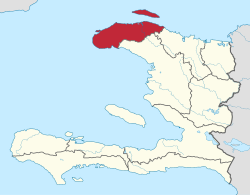Nord-Ouest (department)
Nord-Ouest (English: North-West) is one of the ten departments (French: départments, singular départment) of Haiti. It is in the northwestern part of the country. Its capital is Port-de-Paix.
|
Nòdwès | |
|---|---|
 Nord-Ouest in Haiti | |
| Country | |
| Capital | Port-de-Paix |
| Government | |
| • Type | Departmental Council |
| Area | |
| • Department | 2,102.88 km2 (811.93 sq mi) |
| Population (2015)[1] | |
| • Department | 728,807 |
| • Density | 346.5756/km2 (897.6268/sq mi) |
| • Urban | 203,568 |
| • Rural | 525,239 |
| Time zone | UTC-5 (Eastern) |
| ISO 3166 code | HT-NO |
After the Haitian Revolution, the country was divided into only three departments: Nord, Ouest and Sud. The Nord-Ouest department was part of the Nord department.
Geography
The Départment du Nord-Ouest has an area of 2,176 km².[2] The Tortuga Island is part of this department. The department is in the Northern, or Northwestern, Peninsula. It is a very dry region, except for the Tortuga Island and the area around Port-de-Paix.
The department is bordered to the north by the Atlantic Ocean, to the east by the Nord Department and to the south by the Artibonite Department and the Gulf of Gonâve. To the east is the Windward Passage that separates the islands of Hispaniola and Cuba. On clear nights, it is possible to see the Guantánamo Province of Cuba.
The Massif du Nord-Ouest (in English, "Northwestern mountain range"), with several smaller mountain chains, covers most of the department. Its western end is almost flat and is called the Plateau de Bombardopolis ("Bombardopolis Plateau").[3]
Low lands are found only close to the coast and the most important are the Jean Rabel Valley and the Valley of the Trois-Rivières on the northern part, and the Plain of L'Arbre on the southern part of the department.
The river Trois-Rivières, one of the most important river in Haiti, is in this department. Other smaller rivers are Jean Rabel and du Mole.
History
The northern coast of the Départment du Nord-Ouest was the area that European people first visited in the Hispaniola island during the first visit of Christopher Columbus to the Americas in 1492.[4]
On the night of 5 December 1492 he saw the Cape Saint-Nicolas and the next day he went into the Bay of the Môle-Saint-Nicolas and to the land where now is the town Môle-Saint-Nicolas.
On 7 December, he visited the bays Port-à-l'Écu and Moustique; he named the Moustique Bay ("Mosquito Bay") as Puerto de la Concepción and he stayed there till 13 December. Then he went to the bay of Port-de-Paix and named it Valle del Paraíso or Valparaiso (Spanish for "Paradise Valley") on 15 December.
Population
The department had, in the 2003 census, a population of 531,198 persons: 256,238 men and 274,960 women, with 118,798 (22.36%) living in cities and towns.[5] The population density was, in that year, of 244 persons/km².
Administrative division
The department is divided into three arrondissements (like districts) and 10 communes (like municipalities). The "arrondissements" and their "communes" are:
- Môle-Saint-Nicolas
- Baie de Henne
- Bombardopolis
- Jean-Rabel
- Môle-Saint-Nicolas
- Port-de-Paix
- Bassin Bleu
- Chansolme
- La Tortue
- Port-de-Paix
- Saint-Louis-du-Nord
- Anse-à-Foleur
- Saint-Louis-du-Nord
Economy
The main economic activity in the department is agriculture, with many very small farms where different crops are grown. On the mountains, coffee is grown.
References
- ↑ "Ihsi.ht" (PDF).
- ↑ "Départments géographiques d'Haïti". Haiti-Référence (in French). Archived from the original on 28 January 2010. Retrieved 24 October 2009.
{{cite web}}: CS1 maint: unrecognized language (link) - ↑ Butterlin, Jacques (1956). La constitution géologique et la structure des Antilles (in French). Paris: Centre National de la Recherche Scientifique. p. 99.
{{cite book}}: CS1 maint: unrecognized language (link) - ↑ Columbus, Christopher (1989). The Diario of Christopher Columbus's First Voyage to America, 1492-1493. de las Casas, Bartolomé, Dunn, O.C., and Kelley, James E. Norman: University of Oklahoma Press. ISBN 9780806121017.
- ↑ "Le 4ième Recensement Géneral de la Population et de l'Habitat" (PDF) (in French). Institut Haïtien de Statistique et d'Informatique. Retrieved 24 October 2009.
{{cite web}}: CS1 maint: unrecognized language (link)
| ||||||
| Artibonite • Centre • Grand'Anse • Nippes • Nord • Nord-Est • Nord-Ouest • Ouest • Sud • Sud-Est | ||||||